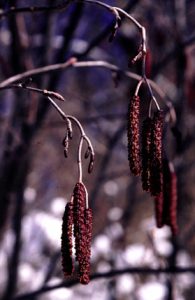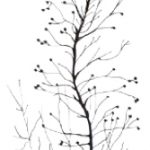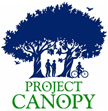Bulletin #2562, Native Trees and Shrubs for Maine Landscapes: Hazel Alder or Speckled Alder (Alnus incana ssp. rugosa)
Developed by Marjorie Peronto, associate Extension professor, University of Maine Cooperative Extension; and Reeser C. Manley, assistant professor of horticulture, University of Maine.
For information about UMaine Extension programs and resources, visit extension.umaine.edu.
Find more of our publications and books at extension.umaine.edu/publications/.
Go native!
This series of publications is the result of a five-year research project that evaluated the adaptability of a variety of native trees and shrubs to the stresses of urban and residential landscapes in Maine. Non-native invasive plants pose a serious threat to Maine’s biodiversity. Plants such as Japanese barberry, shrubby honeysuckle, and Asiatic bittersweet, originally introduced for their ornamental features, have escaped from our landscapes, colonizing natural areas and displacing native plants and animals. By landscaping with native plants, we can create vegetation corridors that link fragmented wild areas, providing food and shelter for the native wildlife that is an integral part of our ecosystem. Your landscape choices can have an impact on the environment that goes far beyond your property lines.
Description
Form: a small understory tree with a rounded crown and multiple crooked and leggy trunks
Size: 20 to 35 feet tall and wide
Ornamental characteristics:
- picturesque growth habit
- purplish red male catkins hang from leafless branches in early spring
- small, woody, cone-like fruits persist in winter
Landscape Use
Speckled alder functions best when naturalized in sunny, wet areas, such as along streams or ponds or in wet spots of open woods. Its habit of sending out many suckers (vigorous vertical shoots emanating from the base of the plant) will eventually lead to the formation of large colonies that function in anchoring the soil and preventing erosion.
Use it with other species that thrive in wet areas, including red maple (Acer rubrum), buttonbush (Cephalanthus occidentalis), and native willows (Salix spp.). Alder thickets are also often crowded with winterberry holly (Ilex verticillata) and mountain holly (Nemopanthus mucronatus).
Culture
Hardiness: USDA zone 2
Soil requirements: prefers moist or wet soils, but will perform well in drier sites; tolerates a wide range of pH
Light requirements: full sun
Stress tolerances:
soil compaction — tolerant
pollution — somewhat tolerant
deicing salts — somewhat tolerant
urban heat islands — intolerant
drought — intolerant
seasonal flooding — tolerant
Insect and disease problems: frequent — borers, alder bark beetles, and tent caterpillars
Wildlife Value
Speckled alder seeds are food for songbirds, water birds, and small mammals. Songbird feeders include black-capped chickadees, redpolls, pine siskins, and American goldfinches. Birds commonly found nesting in alder thickets include yellow-bellied and alder flycatchers, yellow warblers, common yellowthroats, Wilson’s warblers, red-winged blackbirds, swamp and white-throated sparrows, and American goldfinches. Alders are also hosts to several species of butterflies and moths.
Maintenance
Irrigation: During the establishment period, defined as one year after planting for each inch of trunk diameter at planting time, water your trees regularly during the growing season. Give the root zone of each tree 1 inch of water per week; in general, a tree’s root zone extends twice as wide as its canopy. After the establishment period, provide supplemental irrigation during periods of severe drought.
Fertilization: Landscape trees and shrubs should not be fertilized unless a soil test indicates a need. Correct soil pH, if necessary, by amending the backfill soil. No nitrogen fertilizer should be added at planting or during the first growing season.
To learn more about native woody plants
Visit the Eastern Maine Native Plant Arboretum at University of Maine Cooperative Extension’s Penobscot County office, 307 Maine Avenue in Bangor. Established in 2004, the arboretum displays 24 different native tree and shrub species that can be used in managed landscapes.
Reviewed by Cathy Neal, Extension professor, University of New Hampshire Cooperative Extension.
Photos by Reeser C. Manley.
Illustration by Margery Read, Extension Master Gardener.
This series of publications and the associated research were made possible in part by the Maine Forest Service’s Project Canopy.
Information in this publication is provided purely for educational purposes. No responsibility is assumed for any problems associated with the use of products or services mentioned. No endorsement of products or companies is intended, nor is criticism of unnamed products or companies implied.
© 2008
Call 800.287.0274 (in Maine), or 207.581.3188, for information on publications and program offerings from University of Maine Cooperative Extension, or visit extension.umaine.edu.
In complying with the letter and spirit of applicable laws and pursuing its own goals of diversity, the University of Maine System does not discriminate on the grounds of race, color, religion, sex, sexual orientation, transgender status, gender, gender identity or expression, ethnicity, national origin, citizenship status, familial status, ancestry, age, disability physical or mental, genetic information, or veterans or military status in employment, education, and all other programs and activities. The University provides reasonable accommodations to qualified individuals with disabilities upon request. The following person has been designated to handle inquiries regarding non-discrimination policies: Director of Institutional Equity and Title IX Services, 5713 Chadbourne Hall, Room 412, University of Maine, Orono, ME 04469-5713, 207.581.1226, TTY 711 (Maine Relay System).




